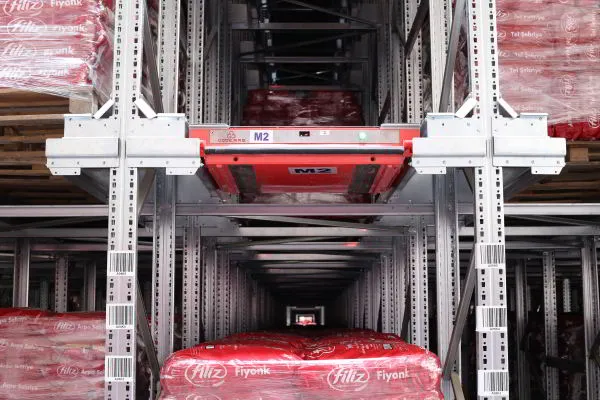Food and Beverages Warehouse Racking
Food and beverage storage rack systems are of great interest to the whole world, especially the new technologies brought by food and beverage companies, in today's world where competition has increased to extremes in every branch. The products, which are packaged after the production stage and sent to their buyers in this way, are kept in warehouses for a certain period of time and then hit the roads to meet the end consumer.
Companies aim to implement logistics processes in the best way and at the lowest cost in order to gain competitive advantage and increase profit rates. Warehouse design, which is the most important part of the process, offers a great competitive advantage for businesses.
In beverage and food industry warehouse shelving systems, the FIFO - first in first out method, in which the first product placed on the shelf for stacking purposes is the first to be released, is the most preferred operating model. Food and beverage storage shelving systems are sometimes stacked on pallets on the floor in order to use empty spaces, instead of stacking on high industrial shelves in warehouse settlements. Some rules and standards should be determined for this method, which is not recommended by storage experts.
Food and Beverage Storage Shelving Systems Features and Advantages
For example, dry food storage should be measured at 20 - 25 degrees, and cold food storage should be measured frequently. If the circulation of the entrance and exit doors of the cold food store is excessive, there will be changes in the thermostat settings of this cold food store, which will lead to storage and energy inefficiency.
In food and beverage storage shelving systems, food and beverages should be stacked in such a way that they are not kept in the warehouse for too long in case of spoilage. The importance of food and beverage storage shelving systems also comes to the fore here. Packaged pallets that can be automatically brought to the logistics center and not damaged are the systems preferred by every company.
You can examine our reference warehouse systems, where our business partners, who want to manage their operational processes well and trust the ÜÇGE Warehouse Racking Systems expert team and production technology in the field of storage systems needs, carry out their durable consumer goods warehouse management.
ÜÇGE DRS is a member of ÜÇGE, which equips stores and warehouses with the latest technology systems. Established in 1976 for service production with the philosophy of being higher and stronger with an effective understanding of goods and services and acting on the strong principles of ÜÇGE.
ÜÇGE DRS, which produces goods and services with high-tech production lines and innovative warehouse solutions, produces specially designed warehouse shelves for the retail and industrial sectors.
ÜÇGE Warehouse Racking Systems offers to the whole world from its Bursa - Mustafakemalpaşa production facilities with the power of its competent staff, customer trust created by unique project management project models and strong technological warehouse solutions focused on customer satisfaction.
What is the importance of the material used in food and beverage industry storage systems?
What is the contribution of the smart warehouse system to profitability in the food and beverage industry?
With a smart warehouse, companies reduce the number of employees in the warehouse, thus reducing human errors to zero and minimizing their costs. When companies use automatic shelving systems in their warehouses, they achieve greater efficiency in terms of cost, speed, workforce support, reliability, durability and expertise.
The satisfaction levels of your consumers will also increase as delivery speeds up and there is zero margin of error in Automated Warehouse Shelving Systems, where all systems are developed with software.
As a result, satisfied customers will not need to work with a different company. In a world where competition is measured in split seconds, automatic systems that can provide customer satisfaction are the choice of all large companies.
How to remove pallets from shelves in food and beverage storage systems?
How to ensure food and beverage storage systems safety?
The topics of warehouse shelving systems occupational safety and warehouse shelving systems periodic control should be discussed together with the project management process and after-sales services policy, as the manufacturer and the supporting company, with the brand's OHS control personnel and occupational safety experts. The inspection report of rack systems in compliance with the TS EN 15635 standard and the qualification controls of work equipment and the warehouse security measures taken are the responsibility of the warehouse management.
According to the TS EN 15635 standard, employees are given short training on issues such as maintenance, labeling, stacking, and the condition of pallets that customers need to do in line with the standards regarding shelf systems.
In order to prevent conditions in which food and beverage industry products become damaged and unconsumable, warehouse management and shipping operation employees are obliged to ensure the cleanliness and hygiene standards of material storage systems areas. In the food and beverage industry, warehouses should be designed to be added to the layout plan after physical, microbiological and chemical contamination simulations. In addition, warehouse management, which controls pest control processes in warehouses, prevents stored palletized food and beverage products from being damaged.
Packaged products and pallets ready for shipment should be clearly defined, and a first-in, first-out philosophy should be applied at the beginning of the shipment process.
Additionally, packaged food and beverage products should not be allowed to remain in warehouses for too long. The storage system, entrance and exit to the work area and personnel rest areas, which are included in the architectural peripheral units during the project process, should not be at a point open to the intervention of foreign objects. The area where the returned and return stocks are kept should be labeled as a very different place from the main storage point.
